di Marco Maculotti
According to many mythical traditions, in the beginning the first members of the human race were generated in the bowels of the Earth, within underground worlds similar to cavernous wombs. The myths of emergence, particularly prevalent among Native American populations, provide us with the best examples of such subterranean realms. The mythical tales tell of how the first humans were brought to the surface to live in the sunlight only after they remained for a long time under the earth's surface, in the - so to speak - "larval" state, and after developing a rudimentary physical form. and a human conscience. According to native peoples, this emergence from the underworld marks the birth of man in the present era - or, to use a typical American term, the "Fifth Sun" - and also represents the transition from childhood and dependence on womb of Mother Earth to maturity and independence.
In most cases, the first human beings who lived in the womb of Mother Earth are said to have had a semi-animal or semi-human form. This brings to mind the mythical beliefs of the Australian Aborigines, according to which in illo tempore, in the "Dream Time", the world already existed but its forms were undifferentiated, which is why there was no precise distinction between gods, human beings and animals; beings differed only later, with the end of the "Dream Time". Even for Native Americans, humans developed fully as such only after rising to the earth's surface.
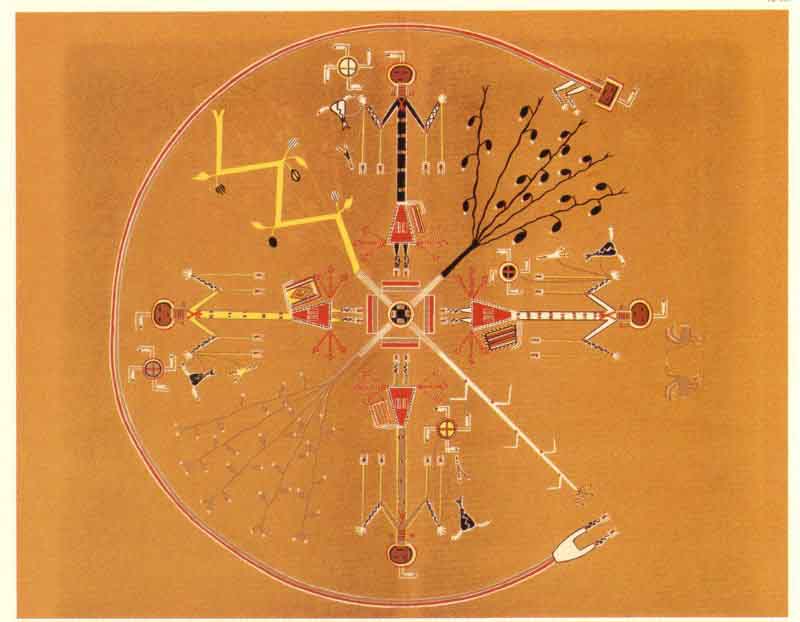
lenape
One of the first missionaries to live with the Lenape Indians (European name: Delaware) of Pennsylvania - mentioned by Kafton-Minkel in his work Underground worlds—He wrote that “the Indians consider the Earth their universal mother. They are convinced that they were created in her womb, where they had their home for a long time, before living on the surface. They claim that when the great, good, and omnipotent Spirit created them, he surely did so because he believed that the right time had come to allow the enjoyment of all the good things he had prepared on Earth, but wisely decreed that the first phase of existence human took place in her womb, as the newborn is formed and begins its development in the womb of the natural mother ». The same missionary also adds that Indian myths “do not agree on the shape of men during their existence in the womb of the Earth. Some affirm that they had a human form while others, with greater consistency, are convinced that the form was the same as that of certain land animals, such as the marmot, the rabbit or the turtle "(Walter Kafton-Minkel, Underground worlds, p.28).
Iroquois
In an Iroquois version of the emergence myth, the earliest underground humans were already human in form, but they lived like babies, like babies being gestated in their mother's womb. A myth collected by a missionary among this people of Eskimos in the far north says that “they dwelt in the land, where it was dark and no sun shone. […] Ganawagahha, having discovered by chance a hole leading to the surface, came out and, wandering on the earth, found a deer that he brought back with him; both for the good taste of the meat and for the favorable description he made of the landscape, their mother decided that the best thing for everyone was to go out. So they did, and immediately they started planting wheat, etc. However, the Nocharauosul, that is to say the marmot, did not go out, preferring to remain underground as before "(Walter Kafton-Minkel, Underground worlds, p.29). The Iroquois myth conveys the idea that there is a price to pay for not leaving the womb at the right moment, also deciding to remain in the dark safety of the maternal womb: the primordial man who did not want to go out, Nocharauosul, refusing independence and maturity, did not know evolution in human form but, on the contrary, regressed to the animal state.
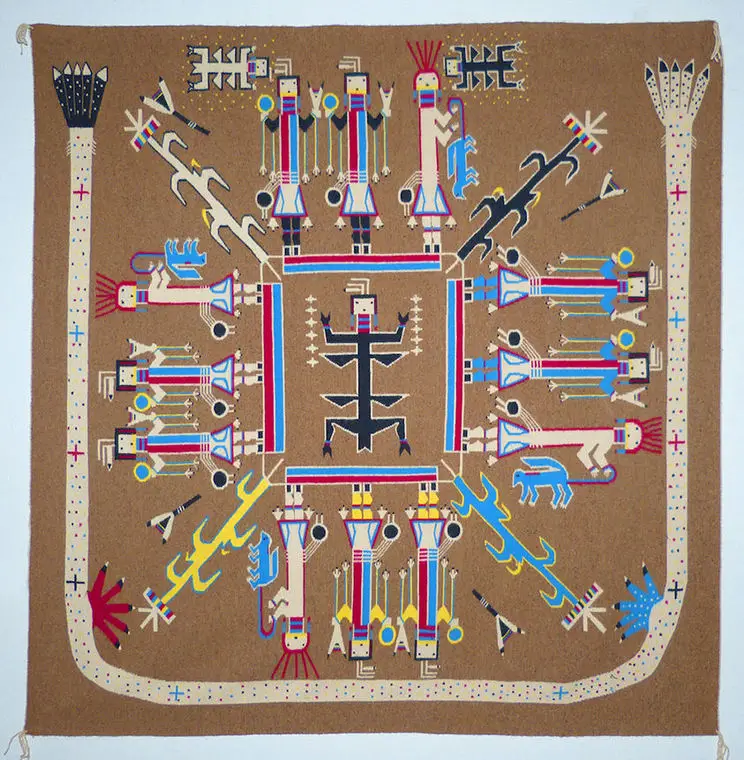
Apache Jicarilla
According to the origin myth of the Jicarilla Apache of northern New Mexico, “In the beginning the earth was covered with water, and all living things were in an underworld. Then people talked, animals talked, trees talked and rocks talked. […] The divine people and animals wanted more light, but the nocturnal animals — the bear, the panther and the owl — wanted darkness. " There was therefore a four-way game between people and divine animals on one side and nocturnal animals on the other. Finally, humanity managed to emerge from the underworld, but “Even though there was light now, people still saw little because they lived [still, ed] in the underwater world. But the sun was high enough to look through a hole and find there was another world, this earth. ' They, therefore, "built four mounds to help them reach the world above" and, after several attempts, they finally succeeded (Erdoes and Ortiz, Myths and legends of the American Indians, pp. 139-140).
However, for the Apache Jicarilla the emergence has not yet ended. In some future period, they argue, this world will no longer be able to sustain life and people will be forced to ascend again, to another Earth, positioned above the sky. Folklore scholar Morris Opler related this tale that a Jicarilla had told him: 'The sun and the moon will rise as before. This place will be dark, and the peoples will follow the sun and the moon. They say there is some of the material left from which the Earth was made ... material for other lands and skies, currently preserved somewhere, covered by a mountain ... They say that the Earth will have to be destroyed twice, once by water , and this has already happened ... In the future it will be destroyed for the second time by fire. Sooner or later it will happen, when the Slayer of Enemies (the hero Jicarilla of the emergence, equivalent to the Gemini of the mythologem Zuni) returns. He will take care of these Indians before it happens and lead them to another place, over the present sky "(Walter Kafton-Minkel, Underground worlds, p.31). From these Native American myths we understand how, in their world view, the human race must progress steadily through the ages, in order not to be left behind in evolution, stuck in the darkness and oblivion of the previous, dark and underground worlds.
Native Americans of the Southwest
The best known and best documented emergence cycles are those of the native populations of the American South-West, in particular those of the Indians generally indicated with the name of Pueblos, namely Hopi, Navajo and Zuni.

zuni
The Zuni Indians believe that in the womb of Mother Earth there are four subterranean worlds-wombs: the same number — it seems curious to us — of the "suns" or eras preceding the present one, in which we live ourselves. In addition to always presenting a rigorously "gynecological" symbolism, the myths of emergence of the native populations of the American Southwest share the image of human beings that germinate in the larval state underground, and then laboriously open their way to the surface and the light of the sun, led by the exploits of legendary heroes. In the Zuni myth, we read that "as many human mothers worry about their unborn firstborn, so did Mother Earth", who asked Heavenly Father: "Once born, how will our children distinguish a place from a other, even in the full light of the Father Sun? ». Thus, for fear that her children were not yet ready for independence, she "kept them in the depths of her most hidden uterus" (Walter Kafton-Minkel, Underground worlds, pp. 29-30).
Even the Zuni Indians, like the Australian aborigines and many other native peoples, hand down that before the emergence there was no precise differentiation between humans and animals. However, unlike the native peoples of Australia, for the Zuni this primeval time was by no means all plain sailing, to the point that primeval humans felt like prisoners of their own mother's womb. “The beings who would become humans and other creatures dwelt in the dark as unfinished animals, caterpillars or tadpoles. They lived in a confined space and were unhappy, crawling and tumbling on top of each other, grumbling, cursing, spitting and moaning. After some time, some of them tried to escape. One of them, a hero named Poshaiyank'ya, climbed up the four wombs of Mother Earth and reached the surface, which in those days was a huge, soft island. Poshaiyank'ya prayed to the Father Sun to deliver the people of him, and the Sun, moved by the prayer, came to his aid. Again he fertilized the great waters and more twins were born, whose names were Uanam Ehkona and Uanam Yaluna, the Brothers of Light and Lords of Mankind. The Twins took large knives made of lightning, split the mountains and with their great shields of clouds broke into the darkness "(Walter Kafton-Minkel, Underground worlds, p.30). We note therefore how, according to the Zuni Indians, the emergence of mankind is favored by a category of supernatural beings, the divine Brothers of present humanity, children of the Sun, who worked to allow our race to conquer maturity by coming out of the abyssal womb of Mother Earth.
The Zuni myth continues: “When they reached the Womb of Dark Depth, the Twins found there many herbs and vine shoots. They blew on the latter and soon the plants began to make their way towards the opening dug by the Twins in the earth. They wove a great ladder of vine shoots and gathered the unhappy inhabitants of the womb. Up the ladder they led them to the second uterus world, the Umbilical Uterus or Place of Gestation, which was dark as a stormy night. Not all creatures, however, managed to climb up the ladder. Many lost their grip and fell back into the darkness of the lower womb. […] After a short stay in the second world, the Twins led the other creatures to the third, the vaginal womb or Place of the Sexual Generation, similar to a valley illuminated by the light of the stars. Here the various tribes of humans and animals began to multiply and diversify, and soon the third world was too crowded. Again the Twins led them up the vine ladder to the fourth world, the Supreme Revelation or Uterus of Birth, where a soft dawn shone. When this world was also filled beyond the limit, the Twins led men and animals in the final climb to the surface of the Earth, to the World Fertilized by Light, Knowledge and Sight ", which is to say the one we currently live in. 'was of the "Fifth Sun".
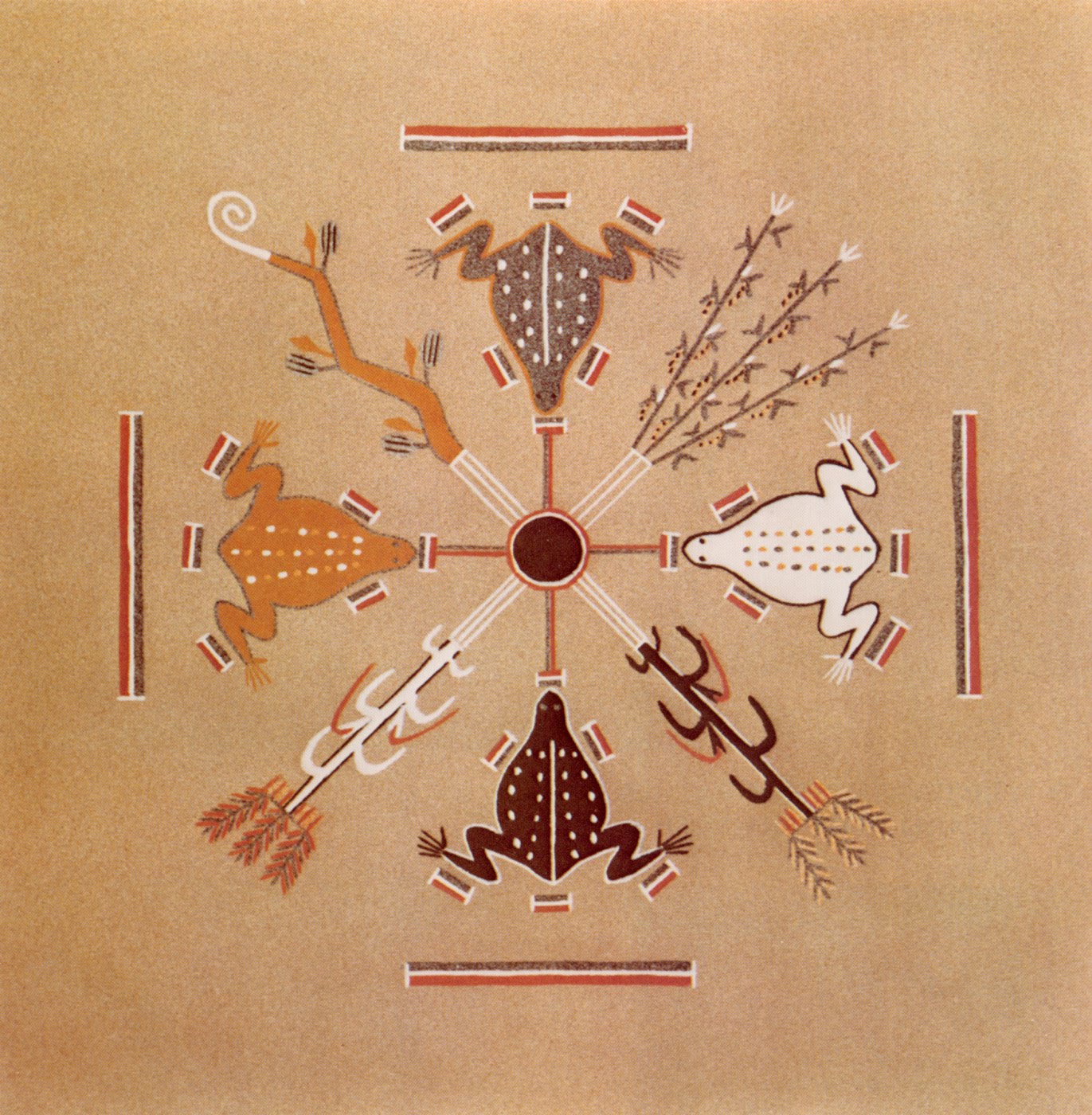
However, by the time they reached the earth's surface, the first humans' looked like cave creatures, with dark, cold, scaly skin, long, wide, bat-like ears, and webbed toes. Even the faint light of the stars hurt their owl eyes, and they crawled like frogs on the ground, as they had done in the caves of the lower worlds. ' But soon they got used to the dazzling light of the sun, they adopted the custom of covering themselves with garments and weaving sandals to walk the earth. The first few days on the surface, of course, were a trauma for nascent humanity. “Mother Earth, in a rage that her children had escaped her protection, she boiled, shook, cracked constantly, and from the cracks came the monsters that had remained behind, imprisoned in her wombs. They assaulted and devoured the new human beings, but the Twins, who had returned to live in heaven, hurled their thunderbolts on the earth and caused great fires that burned the monsters "(Walter Kafton-Minkel, Worlds underground, pp. 30-31) Only after the providential intervention of the heavenly Brothers did the surface of the earth become a suitable place for human life.
Analogies with Greek mythology
Allow us a brief excursus to underline how various passages of the myth of the emergence of Zuni closely resemble Hellenic mythology: even for the Greeks the responsibility of the imprisonment of the primordial race of "monsters" (that is to say those primordial creatures that had not reached the maturity necessary for the emergence, and that therefore in the Zuni myth they fell back into the underground wombs) was of Uranus, that is to say of the celestial divinities. The latter, in fact, prevents the children he generated with Gaea, that is, the twelve Titans, the three Cyclops and the three Centimani, from coming to light; the reason for this refusal would lie in their "monstrosity", exactly as in the Zuni tradition. Here then is that Gaea builds a scythe and invites her children to get rid of the father who forces them into her womb. Only the last of the Titans, Kronos, responds to his mother's call, castrating his father and thus allowing the emergence of his brothers. Even the Zuni myth of the battle between the "monsters" and the nascent humanity brings us back to Greek mythology, that is to the battle between the Olympian gods (equivalent to Gemini or Brothers of Light, celestial deities) and, in fact, the Titans, monstrous children of Gaea, freed by herself. Just as in the Zuni tale the Twins "hurled their thunderbolts on the earth and caused great fires that burned the monsters", so also in the Hellenic tradition Zeus and his celestial brothers will segregate them in Tartarus (that is, in the depths of the underground abyss), with the same weapon: his celestial lightning. The same weapon is also used by Indra, god of lightning and storm, in the Vedic myth in which he kills Vritra to bring the world into existence: "The generous took the vajra, the weapon that is thrown, and struck the first among the snakes. When you, Indra, killed the first among the serpents you also annihilated the deceptions of the liars, generating the sun, the sky, the dawn. (Ṛg see I, 32, 2-4).
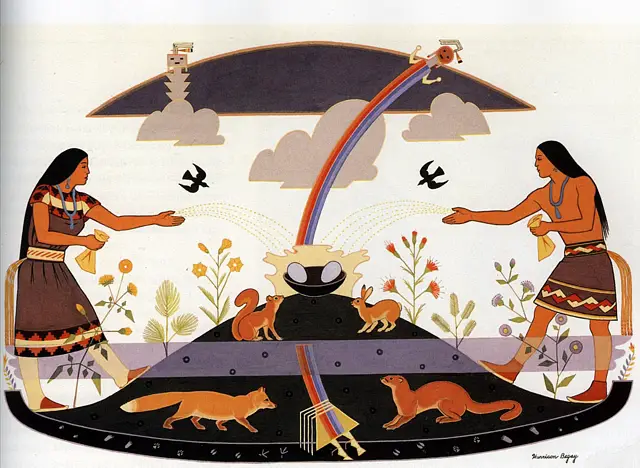
Navajo
The Navajo mythology about the origins of humanity was collected (1908) by his father Berard Haile, and published much later (1981) in the volume Upward Moving and Emergence. The emergence takes place through four levels of the Dark World, which will be followed by the three levels of the Red World, the level of the Yellow World, the next level of the Yellowish World, the level of the Eleventh Speech and finally the actual emergence on the surface of the earth. . This tale is part of the traditional ceremony of the Upward Movement and the Emergence (haneelneehee), in which it is told of how the Navajo people managed to defeat the diseases of the lower world thanks to the use of a magical-therapeutic power that proceeds upwards and which counteracts the downward thrust, disorder, darkness. , illness, undifferentiation (Enrico Comba, Myths and mysteries of the American Indians, pp. 641-642). Even the myth of the origins of the Navajo Indians tells of how the first human beings reached the earth's surface through a long series of events, which led them to go up step by step a series of underground worlds. The latter were described as hemispheres or as buildings, placed one above the other, for a total of up to fourteen underground worlds. Each of these underground worlds is identified by a number, by a color and by the various events that took place there. The process of emergence therefore begins in the center of the lower world and progressively develops, ascending by means of a long ascent towards the sky, passing from one underground world to the next. Note, however, that the Navajo term for land is naestan, indicating a woman in a horizontal or reclined position.
Even for the Navajo, in illo tempore, the underworlds were inhabited by undifferentiated creatures, which they call "insects" or some other animal name, which, however, were not like the insects or the animals we all know today. Although, in fact, they had common characteristics with current animals, they also had the gift of speech and lived and behaved according to the norms and customs of human beings: in practice, they were undifferentiated beings placed halfway between the animal and the human state. “In the Dark Underworld,” they say, “there were no birds, no trees, no rocks, not even men like here. Only the Ant People (and the Beetle People) lived there. " In all, the races of these "insects" were nine in number, and they differed in color (yellow, red or black) and in size. In the second underground world, following the first emergence, a so-called Locust People is also detected, which is therefore added to the group of previous insect-peoples that emerged from the first underground uterus. These primeval beings try in vain to find a place to live in peace and harmony, but each time something makes their residence unsuitable or unpleasant, due to the sudden arrival of the forces of disorder and darkness. Over time, in the world of the Fourth Discourse, other beings appear alongside the undifferentiated beings (First Man, First Woman, First Boy and First Girl), who however are not the first members of the human race as we know it today: the myth he speaks of them as "Old People" who, among other things, "practiced witchcraft" and who caused death and disease. Coyote also lived in this fourth underworld, also called Son of Dawn, Son of the Blue of Heaven, Son of Evening Sunset and Son of Darkness, a divinity with dual and luciferian characteristics, trickster par excellence of the native tradition. However, it was precisely the world of the Fourth Discourse that knew the beginning of the Rite of Movement upwards, from which we deduce that this ceremony was invented precisely by the Elderly People and by the demiurgic Coyote. In fact, it was they, and not the insect-peoples of the previous underground worlds, who gradually emerged in the various subsequent worlds, thanks precisely to the ceremony they invented. However, they knew that going up through the central pillar of the Fourth World they would bring with them a "basket containing diseases and evils of all kinds" (identical to the Pandora's box of the Hellenic myth) located, in fact, inside the central pillar on which they had to go up to emerge in a new world (Enrico Comba, Myths and mysteries of the American Indians, pp. 642-648).
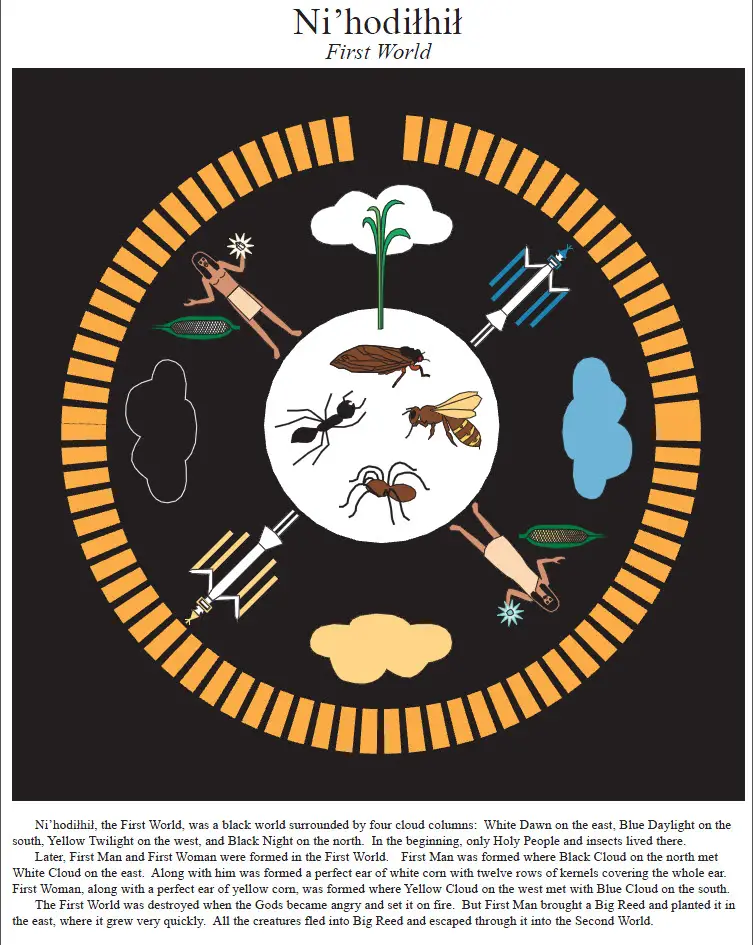
hopi
As we have seen, the idea of the origin of the human race from the underground regions is common to all peoples of the American Southwest. Even the Hopi tradition does not differ: in their myth the history of humanity presents itself as a slow ascent through several superimposed worlds, up to the surface of the present earth. Even for the Hopi, prior to the emergence, there is no precise differentiation between beings: «When the world was new, men and other creatures did not live and things did not exist above the earth, but below. Everything was immersed in the darkest darkness, both above and below. There were four worlds, this world (the top of the earth) and three cavernous worlds, one below the other ». Even in the myth of the Hopi, the need for a progressive emergence arises from the living conditions of the underground worlds, which promptly become unsuitable for life due to overcrowding and the spread of unrest.
The Hopi tale recalls that of the Zuni Indians not only for the number of underground worlds it attests (four in both cases), but also for the role played by two mythical figures, "the Two, two boys, the elder brother and the younger », Obviously very similar to the Twins of the Zuni tradition, as well as to an infinity of mythical Gemini or divine Brothers (Romulus and Remus, the Hellenic Dioscuri and so on) that recur in the traditions of the whole planet as cultural heroes or initiators of lineage. In the Hopi myth, “the Two pierced the ceiling of the caves and descended into the dark living room of men and beings. Then they planted all the growing plants one after the other, hoping that one of them would grow until it reached the opening through which they had descended and still have the strength to bear the weight of men and beings, in so that by climbing on it they could reach the second world of caves ». The plant that suited the Two was the reed, since "it was made in segments, so that it could be easily climbed, and to this day the reed has grown in segments as can be seen today along the Colorado. […] Along this reed many men and other creatures climbed up to the second level of the caves. When part of them had gone up, fearing that the second cave world […] would be too small, they shook the cane ladder so that those who were climbing would fall back down. Then they pulled the ladder away, to prevent the others from climbing. It is said that those who remained eventually managed to get away. They are our brothers who live in the West ». As in the Zuni, Navajo, Iroquois and others tradition, therefore, in every phase of the emergence there are beings who remain behind, stuck in the dark underground womb: sometimes they are described as immature beings, not yet independent (the marmot of the Iroquois myth) , at other times as monsters (Zuni), at other times (Hopi) as victims of the egoism of the beings who ascended before them (Enrico Comba, Myths and mysteries of the American Indians, pp. 674-676).
The Hopi emergence continues through the various underground worlds: in the third womb “all women went mad: they neglected everything to dance, they even forgot about their children. […] Then there were no days, but only one night ». Men, determined to seek a way of salvation from the darkness that oppressed them, managed to ascend to the fourth world, but found it as dark as the previous ones, "because the earth was closed by heaven, just as the worlds of the caves were closed by the own ceiling ". It is therefore our world, with the only difference that at the time there were no luminaries in the sky that could illuminate its surface and allow the human race a suitable life. However, “along with the men who came out […] there were five beings: Spider, Vulture, Swallow, Coyote and Locust. People and these beings consulted on how to produce light ». After various vicissitudes, the divine beings managed to place the stars and other luminaries in the sky and the world was illuminated. But the Hopi myth names other obstacles on the path of their own people: «Other difficulties were encountered by the people on their way, as they discovered men and creatures who had gone out before them. These people waged war as they were pushed by wizards. […] Now, among these people who had gone out before our ancestors, was the great warrior, the Navaho. He was created and sent to protect all men, so he was a great warrior from the very beginning. But when he saw how powerful he was, he turned bad and turned against those he had been sent to protect. Then all men turned against him "(Enrico Comba, Myths and mysteries of the American Indians, pp. 676-681). As usual, the divine figure who anticipates the human race in the emergence on the highest floor and who initially protects it and favors its ascent (Coyote and the Elderly Persons of the Navajo myth), with the passage of time betrays its task. and begins to oppress it. The Hopi Indians gave these beings the name of their closest adversaries to underline the hatred felt towards them due to the internal struggles they had to face daily.
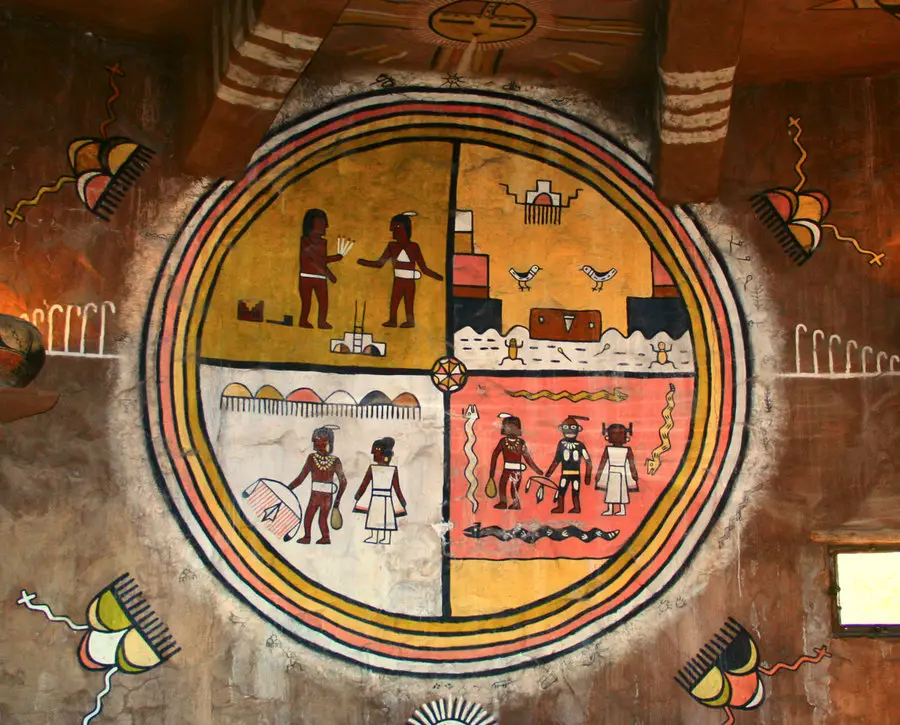
How to understand the myths of emergence?
A comparative reading of the myths we have analyzed in this investigation leads us to a conclusion that, on closer inspection, is rather obvious: it would be wrong to take the so-called "emergence myths" literally and really think that humanity has passed from a world underground (in a purely physical sense) to the superior, and so on for a series of phases. Like all cosmic myths concerning the world of origins, the creation of the world and the coming into existence of the human race to which we belong, they indeed convey deeper concepts, of which the central one, in this case, is undoubtedly the ascent. of mankind, through the ages, from a state of undifferentiation with the rest of beings (animals, plants and rocks) to an increasingly perfected level of consciousness, which allows them to distinguish themselves and rise above the beings who, failing to to emerge, as it were, they "stay behind", stuck at a lower, subterranean, dark, uterine level. In other words, in the Native American traditions, the main task of man (and of the human race in general) consists in cyclically evolving from a lower state of existence (the undifferentiated beings, the "monsters") to a higher one, following the way that divine beings have created and planned (or perhaps it would be better to say "beaten") for us.
From narration to narration, it is regularly attested that humanity has always been helped in its "emergence" by supernatural beings, sometimes called "Brothers of Light", "Sacred Persons", Katchinas from the Hopi, divine Twins and so on. They (the "Older Persons") are on a higher level of the evolutionary ladder than ours, as they exist before us and have "emerged" before us. Many myths underline the ambiguous character of these beings, who, precisely because of the duplicity of their behavior towards humanity in need of help, often rise to the role of trickster that, if on the one hand they favor human beings to emerge from the underground worlds, on the other hand they later stain themselves with unforgivable sins towards the human race, bringing it diseases and misfortunes. In these narratives, we recognize the echo of an ancestral truth that is lost in the mists of time: the existence of divine beings who in the West have been called "Titans" or, in the Judeo-Christian tradition, "Fallen Angels". In other words, they are those beings variously named (the spirits of the shamanic tradition, the Enochian "Watchers", etc.) who have always exerted an indelible influence on the history of the human race, sometimes in a benevolent way.—Conferring them customs, sacred ceremonies and knowledge, such as that of the "Upward Movement", that is to say "of the spiritual ascent"—sometimes, however, oppressing their existence with their hubris, the guilt of which the Titans hurled by Zeus into Tartarus and the "rebel Angels" hurled into the Abyss by the God of the Old Testament stained themselves.

It should be noted, however, that following this hypothesis we must recognize the inexistence of a rigid distinction between animals, men and gods: or rather, the spiritual beings that Native Americans call "Sacred Persons" were, in a previous Sun, beings of our own level who then ascended to a higher level, emerging Before us. For this reason they are also called «Elderly People», since they anticipated us on the evolutionary and ascensional path. With good reason, therefore, the pre-Socratic philosopher Heraclitus intuited that "Man is a mortal god, god is an immortal man". Furthermore, there is no effective distinction between humans and animals: the latter, in the next Suns, will also be able to perfect their level of consciousness and emerge; in the same way the Adamic man, in ancestral times, existed in a primordial form, not yet ripe for emergence. The whole discourse therefore applies to the whole range of beings, from the rock to the angel.
The "cane" or central pillar through which, in the ritual of the "Upward Movement", the shaman and with him all humanity ascends to a higher level, is clearly the symbol ofAxis of the world, the Cosmic Tree present in all ancient traditions. Just think of the vine on which the Amazon shaman ascends to the spirit world or descends to the underworld; think also of the biblical "ladder" that Jacob experienced the vision of during a state of consciousness that we could undoubtedly define "shamanic". We could also recall what is said about the "Scale of Beings" in the titled Alexandrian treatise Corpus Hermeticum and attributed to the mythical Hermes Trismegistus and much more; we believe, however, that the examples proposed by us may, in this work, be sufficient to enlighten the reader (for other examples of "cosmic poles" in shamanic cultures, consult the never exceeded Shamanism and the techniques of Ecstasy di Mircea Eliade). The shape of the tapee, the tent of the Indians in which the sacred ceremonies of invocation of the spirits take place, moreover, also follows the myths of emergence: its funnel shape upwards, with a hole on the top to allow the descent of the spirits in it and the shaman's ascent to the supernal world, reveals a pattern that is found almost in all parts of the world, from the Inuit Eskimos to the Indo-European peoples (in Hindu temples, for example, it is mandatory that there is an opening on the ceiling for allow dialogue with supernal powers). Indeed, whenever we find an opening in the ceiling or on the highest point of a building, we must interpret it as a gateway to a higher realm of being: whoever will have sufficient maturity, during a sacred ritual, to emerge from the world underground in which he is, he will be able to access the higher level by passing metaphorically through this opening, as his ancestors did in myth when, emerging, they passed from an inferior to a superior world.
From the moment when, as they say in multiple mythic narratives, "access to heaven was blocked", "the cosmic pole was destroyed" (in some myths, such as that of the Hopi, by "those who had already ascended") and other similar phrases, the knowledge of the upper world and of the means to access it was irretrievably lost, remaining solely the prerogative of the shaman, that is to say of that restricted category of individuals who in the eras of disorder and darkness manage, despite everything, to reconnect with the " central pillar "of this world, to converse with the spirits in the supernal world or to meet the souls of the deceased in the underworld (ie the various" underground "worlds with respect to the one in which we live, or the" womb-worlds "of the narratives mythical natives). On the other hand, if our analysis is correct, even our world, if compared to the supernal one in which the highest spirits live, is a real "womb", an "underground world" in which, in this cycle current, humanity finds itself imprisoned and from which, when the disorder and darkness become unbearable, it will have the possibility to escape and free itself, following the path of the "Sacred Persons": emerging, with a "Upward Movement". In this fateful future moment will take place the return of the divinity called by the Apaches "Slayer of Enemies", whose task is the same as that of Kalki for the Hindus and of Maitreya for the Buddhists (as well as that of Christ in his future "Second Coming »): To allow the deserving members of the human race to ascend, so as not to get stuck in the darkness and disorder, in the" underworld "of the next Sun.
REFERENCES
- Henry Comba, Myths and mysteries of the American Indians (Utet, 2001).
- Mircea Eliade, Shamanism and the techniques of Ecstasy (Mediterranean, 2005).
- Richard Erdoes and Alfonso Ortiz, Myths and legends of the American Indians (Mondadori, 1994).
- Walter Kafton-Minkel, Underground worlds (Mediterranean, 2012).
- Rig Veda (Psyche, 1998).

6 comments on “The "myths of emergence" in the traditions of Native Americans"